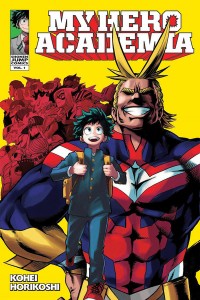By Hideyuki Furuhashi and Betten Court, based on the story by Kohei Horikoshi. Released in Japan as “Vigilante: Boku no Hero Academia Illegals” by Shueisha, serialization ongoing in the magazine Weekly Shonen Jump +. Released in North America by Viz.
My Hero Academia, the main series, is very explicitly based on the American concept of superheroes. And, despite the occasional foray into “yes, heroes really do die” and an examination of loss, for the most part it remains a very idealistic series that wears its heart on its sleeve. Therefore, there was absolutely room for a “grim and gritty” take on the Academia universe, though it won’t be featuring any of the main students. If Horikoshi read a lot of Superman, then (as he explicitly states in the author’s notes) Furuhashi is modeling this spinoff after Batman. And, given the design of the “let’s punch everything” vigilante Knuckleduster, it’s pretty clear we’re talking the Frank Miller Batman. That said, this is still My Hero Academia, so I don’t expect things to get completely hopeless. Mostly as, if the “mentor” figure is Batman, the “hero” is… well, Deku. Something the authors also explicitly admit.
Our hero is Koichi, who is in college and trying to hold down a part-time job. Unlike Izuku at the start of MHA, he DOES have a quirk – he can glide along the ground. Slowly. Most people think he resembles a cockroach. He spends his off time doing nice things like picking up litter, to the point where the neighborhood gives him the hero name “Nice Guy”. He also has run ins with a group of bullies… wait, he’s out of high school, so they get to be thugs – as well as a self-styled wannabe pop idol. And, thanks to a variety of circumstances, he also ends up trying to stop an underground drug trade, which makes people’s powers go out of control, turning them into villains, also also seems, very disturbingly, to be controlled by bees. But it’s OK. He can glide. The wannabe idol can jump really high, and then there’s Knuckleduster, who has no quirk, but is GOOD AT PUNCHING.
As I said, we’re dealing here with mostly original characters. Eraser Head shows up at one point to help compare and contrast the difference between licensed heroes and vigilantes, but the core of the series is our three “illegal” heroes. Of the three, Pop Step is the most problematic. My Hero Academia has been criticized a bit for having the female characters get less focus than the guys, and their costumes overly sexualizing them, and that’s not wrong. But over the course of the first volume, Pop Step is captured multiple times, threatened with rape, and the sadly very popular “covered from head to toe in gloop which probably reminds the reader of something”. Knuckle Duster fares better – he’s in the Frank Miller style, but it’s taking the good bits of Miller and leaving out all the claptrap. As for Koichi, he’s a nice kid, but so far is defined personality-wise as “Deku, only less shiny because this is a “grim and gritty” spinoff. He needs more oomph.
On the good side, the action sequences are very well handled here, and there are some nice creepy horror images with the bees. Vigilantes is a decent enough start for a MHA spinoff, and I hope it gives better development to its leads in future volumes. And stops having Pop Step get captured all the time.



